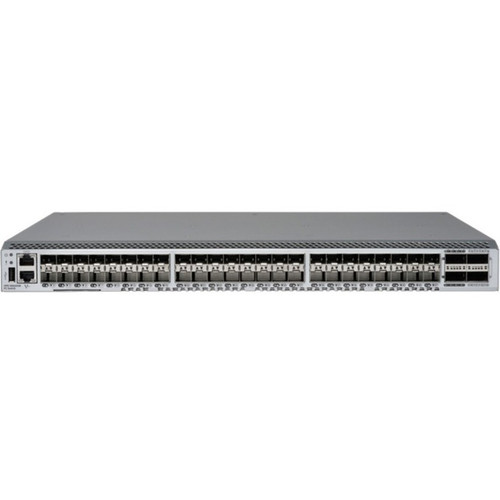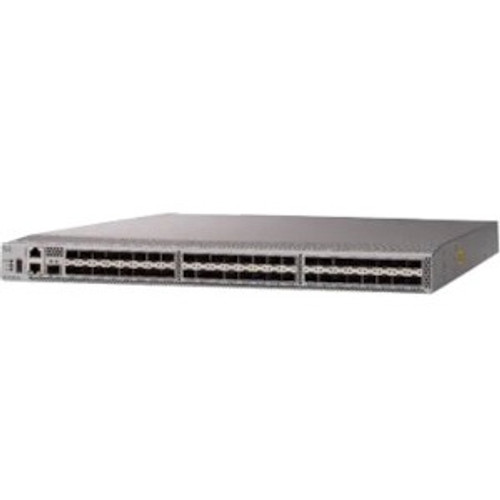Product Description
The next-generation Cisco®MDS 9148T 32-Gbps 48-Port Fibre Channel Switch provides high-speed Fibre Channel connectivity for All-Flash arrays. This switch offers state-of-the-art analytics and telemetry capability built into its next-generation Application-Specific Integrated Circuit (ASIC) platform. This switch allows seamless transition to Fibre Channel Non-Volatile Memory Express (FC-NVMe) workloads whenever available without any hardware upgrade in the SAN. It empowers small, midsize, and large enterprises that are rapidly deploying cloud-scale applications using extremely dense virtualized servers, providing the benefits of greater bandwidth, scale, and consolidation. Some of the main benefits for a small-scale Storage Area Network (SAN) are automatic zoning, nonblocking forwarding, and smaller port groups of 16 ports. Benefits for a mid- to large-size SAN include higher scale for Fibre Channel control-plane functions, virtual SANs, Fabric Login (FLOGI), device alias and name server scale, 48 ports of 32-Gbps non-oversubscribed line-rate ports, bidirectional airflow, and a fixed-form FC-NVMe-ready SAN switch with enhanced Buffer-to-Buffer (B2B) credits connecting both storage and host ports and Fibre Channel link encryption. Large-scale SAN architectures built with SAN core directors can expand 32-Gbps connectivity to the server rack using these switches in either switch mode or Network Port Virtualization (NPV) mode. Additionally, the switch supports enhanced diagnostic features such as Inter-Switch Link (ISL) and Host-Bus-Adapter (HBA) diagnostics, read diagnostic parameter, link cable beacon, and advanced reliability features such as Forward Error Correction (FEC) with HBA ports.
- High performance:
- MDS 9148T architecture, with centralized nonblocking arbitration, provides consistent 32-Gbps low-latency performance across all traffic conditions for every Fibre Channel port on the switch.
- Fully integrated SAN analytics:
- This feature-rich switch also offers state-of-the-art SAN analytics and telemetry capabilities that have been built into this next-generation hardware platform. This new state-of-art technology couples the next-generation port ASIC with a fully dedicated Network Processing Unit designed to complete analytics calculations in real time on the 32-Gbps line card. The telemetry data extracted from the inspection of the frame headers are calculated on board (within the switch) and, using an industry-leading open format, can be streamed to any analytics-visualization platform.
- Capital Expenditures (CapEx) savings:
- The 32-Gbps ports allow users to deploy them with existing 16- or 8-Gbps transceivers provide investment protection with an option to upgrade to 32-Gbps transceivers and adapters whenever needed.
- High availability:
- MDS 9148V switches is designed to provide 99.999% availability. It provides such outstanding availability and reliability by providing redundancy on all major components, such as the power supply and cooling subsystems. Dual power supplies also facilitate redundant power grids. In addition, port-channel link members can be striped across the three 16-port port groups, thus providing additional high availability.
- Reliability:
- As part of the standard 32-Gbps Fibre Channel specification, Cisco provides FEC between switch ports and HBA ports on all 32-Gbps Fibre Channel fixed switches. This feature helps ensure any error introduced in flight gets corrected before it reaches the device side. In addition, Cisco extends Buffer-to-Buffer State Change Notification (BBSCN) and buffer-to-buffer credit recovery, which is supported on all Cisco switches between ISL ports, to the fabric ports attached to any end device. Over time, the corruption of receiver-ready messages, known as R_RDY primitives, can lead to a loss of credits, which can eventually cause a link to stop transmitting in one direction. Buffer-to-buffer credit recovery provides for two attached ports to detect and correct this situation.
- Growth in small increments:
- The MDS 9148T Fibre Channel switch provides an option to deploy as few as twenty-four 32-Gbps Fibre Channel ports in the entry-level variant, which can grow in increments of 8 ports to up to 48 ports. This setup allows four possible configurations of 24, 32, 40, and 48 ports.
- Next-generation ASIC:
- The MDS 9148T Fibre Channel switch is powered by the same high-performance 32-Gbps Cisco ASIC that powers the Cisco MDS 32-Gbps Fibre Channel product portfolio.
- Higher scalability:
- Increased fabric scalability provides more flexibility for a variety of SAN architectures.
- Telemetry:
- Fibre Channel and Small Computer System Interface (SCSI) headers can be inspected without the need for any external taps or appliances. The resulting metrics can be analyzed on the switch and also exported using a dedicated 1- or 10-Gbps Small Form-Factor Pluggable Plus (SFP+) port for telemetry and analytics purposes#.
- Intelligent services:
- Auto-zone, Smart Zoning, slow-drain detection and isolation, Virtual SAN (VSAN) and Inter-VSAN routing (IVR), and fabricwide Quality of Service (QoS) enable migration from SAN islands to enterprise.wide storage networks. Traffic encryption is optionally available to meet stringent security requirements.
 US Dollars
US Dollars
 United Arab Emirates Dirham
United Arab Emirates Dirham
 Euro
Euro
 British Pound
British Pound
 Turkish Lira
Turkish Lira
 Canadian Dollar
Canadian Dollar
 South African Rand
South African Rand
 Indian Rupee
Indian Rupee
 Brazilian Real
Brazilian Real
 Indonesian Rupiah
Indonesian Rupiah
 Singapore Dollar
Singapore Dollar
 South Korean Won
South Korean Won
 Japanese Yen
Japanese Yen
 Chinese Yuan
Chinese Yuan
 Mexican Peso
Mexican Peso
 Qatari Rial
Qatari Rial
 Saudi Riyal
Saudi Riyal









